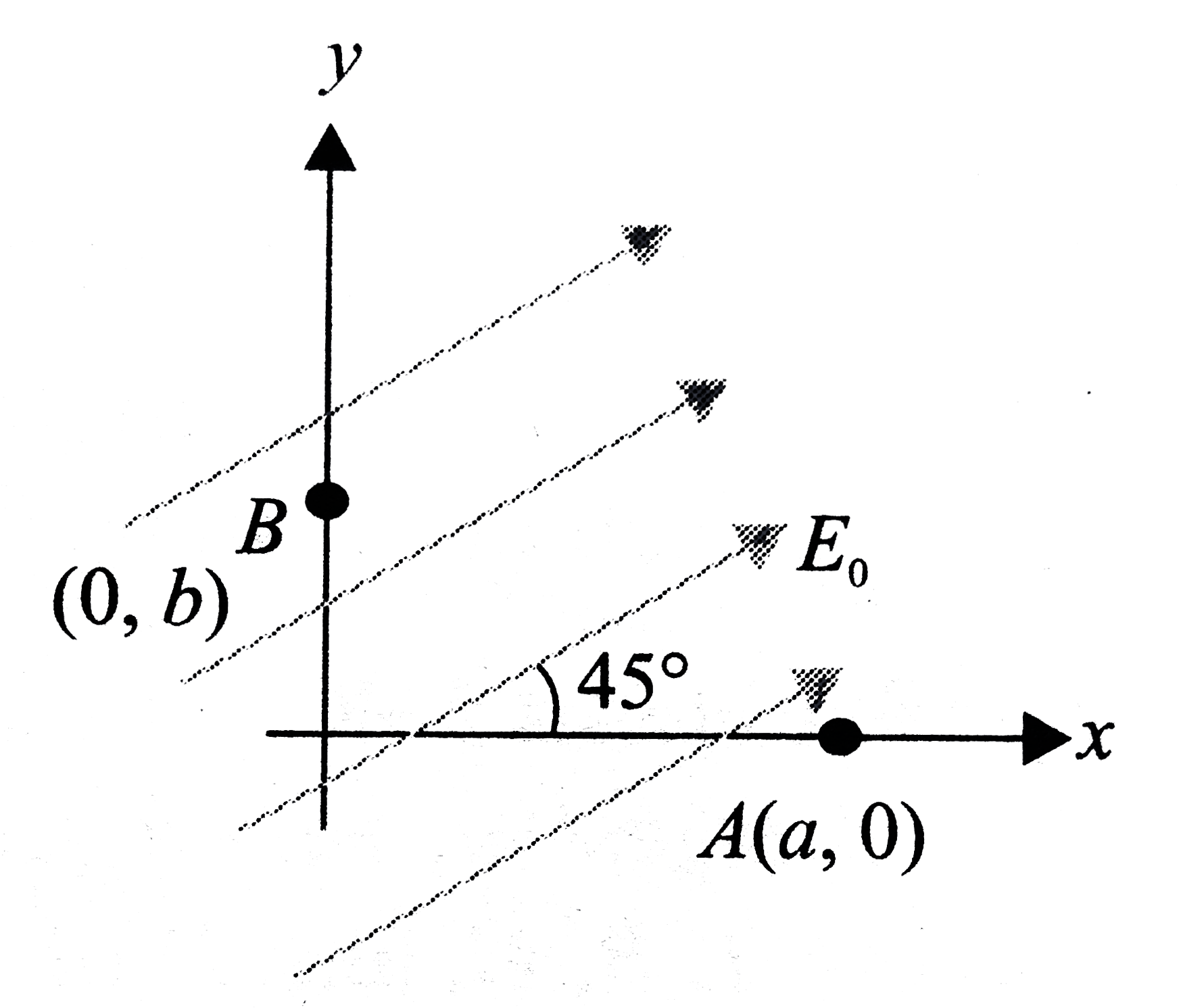Uniform electric field exists in a region and is given by →E=E0ˆi+E0ˆj. There are four points A(−a,0),B(0,−a),C(a,0),andD(0,a) in the xy plane. Which of the following is the correct relation for the electirc potential?
VA=VC>VB=VD
VA=VB>VC=VD
VA>VC>VB=VD
VA<VC<VB<VD
The correct Answer is:B
To solve the problem, we need to analyze the electric potential at the four points A, B, C, and D in the given uniform electric field →E=E0^i+E0^j. The relationship between electric field and electric potential is given by:
→E=−∇V
This implies that the change in electric potential dV can be expressed as:
dV=−→E⋅d→r
Where d→r=dx^i+dy^j.
Step 1: Calculate the electric potential at each point
1. Point A (-a, 0):
VA=−∫(−a,0)(0,0)→E⋅d→r
=−∫−a0E0^i⋅dx^i−∫00E0^j⋅dy^j
=−(−E0a)=E0a
2. Point B (0, -a):
VB=−∫(0,−a)(0,0)→E⋅d→r
=−∫00E0^i⋅dx^i−∫−a0E0^j⋅dy^j
=−(−E0a)=E0a
3. Point C (a, 0):
VC=−∫(a,0)(0,0)→E⋅d→r
=−∫a0E0^i⋅dx^i−∫00E0^j⋅dy^j
=−E0a
4. Point D (0, a):
VD=−∫(0,a)(0,0)→E⋅d→r
=−∫00E0^i⋅dx^i−∫a0E0^j⋅dy^j
=−E0a
Step 2: Summarize the potentials
From our calculations, we have:
- VA=E0a
- VB=E0a
- VC=−E0a
- VD=−E0a
Step 3: Establish the relations
From the results:
- VA=VB
- VC=VD
- VA>VC and VB>VD
Thus, the correct relations for the electric potential are:
VA=VB>VC=VD
Final Answer
The correct relation for the electric potential is:
VA=VB>VC=VD
VA=−∫(−a,0)(0,0)→E⋅d→r
=−∫−a0E0^i⋅dx^i−∫00E0^j⋅dy^j
=−(−E0a)=E0a
VB=−∫(0,−a)(0,0)→E⋅d→r
=−∫00E0^i⋅dx^i−∫−a0E0^j⋅dy^j
=−(−E0a)=E0a
VC=−∫(a,0)(0,0)→E⋅d→r
=−∫a0E0^i⋅dx^i−∫00E0^j⋅dy^j
=−E0a
VD=−∫(0,a)(0,0)→E⋅d→r
=−∫00E0^i⋅dx^i−∫a0E0^j⋅dy^j
=−E0a
- VA=E0a
- VB=E0a
- VC=−E0a
- VD=−E0a
- VA=VB
- VC=VD
- VA>VC and VB>VD
VA=VB>VC=VD
VA=VB>VC=VD
Topper's Solved these Questions
- MISCELLANEOUS VOLUME 3BOOK - CENGAGE PHYSICS ENGLISHCHAPTER - MISCELLANEOUS VOLUME 3EXERCISE - Assertion and Reason Type
8 Videos
- MISCELLANEOUS VOLUME 3BOOK - CENGAGE PHYSICS ENGLISHCHAPTER - MISCELLANEOUS VOLUME 3EXERCISE - Comprehension Type
94 Videos
- MAGNETIC FIELD AND MAGNETIC FORCESBOOK - CENGAGE PHYSICS ENGLISHCHAPTER - MAGNETIC FIELD AND MAGNETIC FORCESEXERCISE - Multiple Correct Answer type
2 Videos
- MISCELLANEOUS VOLUME 5BOOK - CENGAGE PHYSICS ENGLISHCHAPTER - MISCELLANEOUS VOLUME 5EXERCISE - Integer
12 Videos
Similar Questions
Electric field in a region is given by E=(2ˆi+3ˆj−4ˆk)V/m. Find the potential difference between points (0, 0, 0) and (1,2,3) in this region.
View SolutionA uniform electric field E0 exists in a region at angle 45∘ with the x - axis. There are two point A(a,0)andB(0,b) having potential VAandVB, respectively, then
 .
.
View SolutionThe gravitational field in a region is given by →E=(4ˆi+3ˆj)N/Kg. The gravitational potential at the points (3m, 0) and (0, 4m). If the potential at the origin is taken to be zero.
View SolutionFour distinct points (a, 0), (0, b), (c , 0) and (0, d) are lie on a plane in such a way that ac = bd, they will
View SolutionFind the coordinates of the point equidistant from the four points A(0,0,0) , B (a,0,0) , C(0,b,0) and D(0,0,c) .
View SolutionGiven four points A(2,1,0),B(1,0,1),C(3,0,1)andD(0,0,2). Point D lies on a line L orthogonal to the plane determined by the points A, B and C.
View SolutionThe electric field in a region of space is given by, →E=E0ˆi+2E0ˆj where E0=100N/C. The flux of this field through a circular surface of radius 0.02m parallel to the Y-Z plane is nearly.
View SolutionConsider the motion of a positive point charge in a region where there are simultaneous uniform eletric and magnetic field E=E0ˆj and B=B0ˆj. At time t=0, this charge has velocity v in the x-y-plane making an angle θ with the x-axis. Which of the following option(s) is (are) correct for time t>0?
a. If θ=00 the charge moves in a circular path in the xy-plane.
b.Ifθ=00 the charge undergoes helical motion with constant pitch along the y-axis.
c. If θ=100 the charge undergoes helicalmotion with its pitch increasing with time along the y-axis.
d. If θ=90∘ the charge undergoes linear but accelerated motion along the y-axis.
View SolutionLet V0 be the potential at the origin in an electric field →E=4ˆi+5ˆj. The potential at the point (x,y) is
View SolutionThe gravitational field in a region is given by →E=−(20Nkg−1)(ˆi+ˆj). Find the gravitational potential at the origin (0,0) in Jkg−1
View Solution
